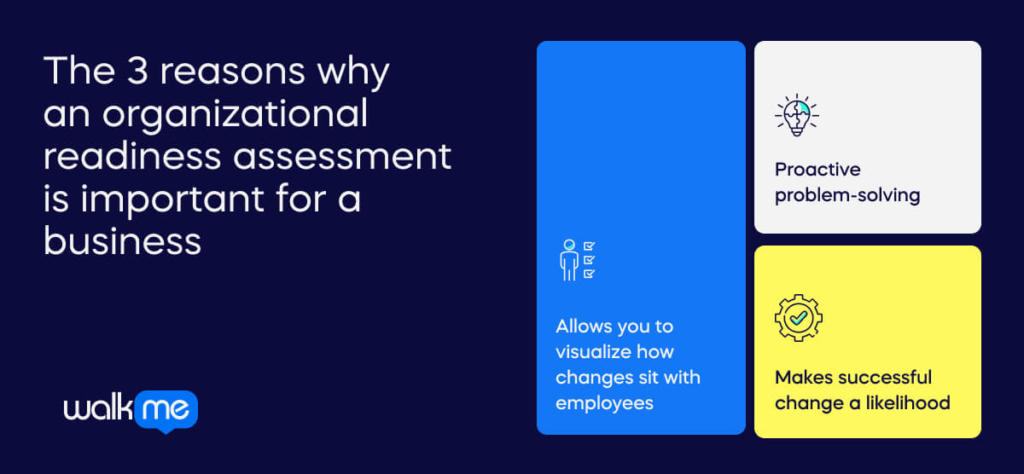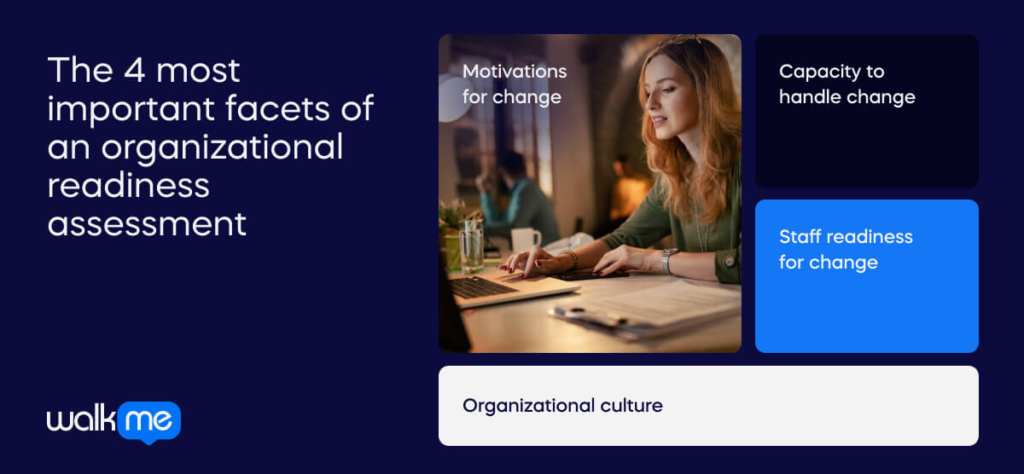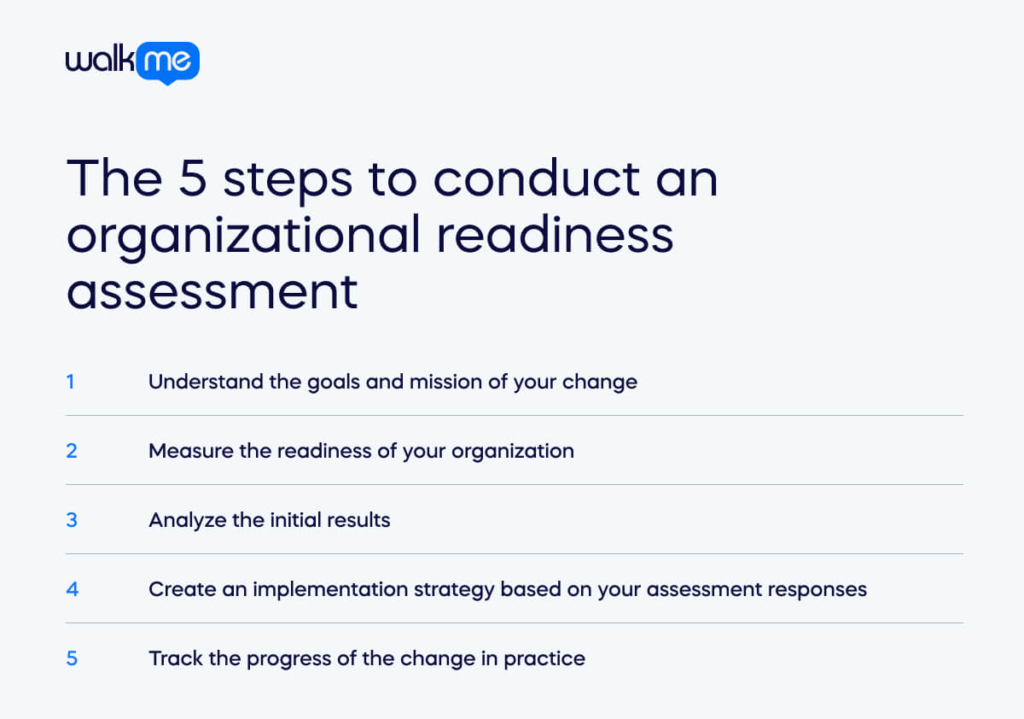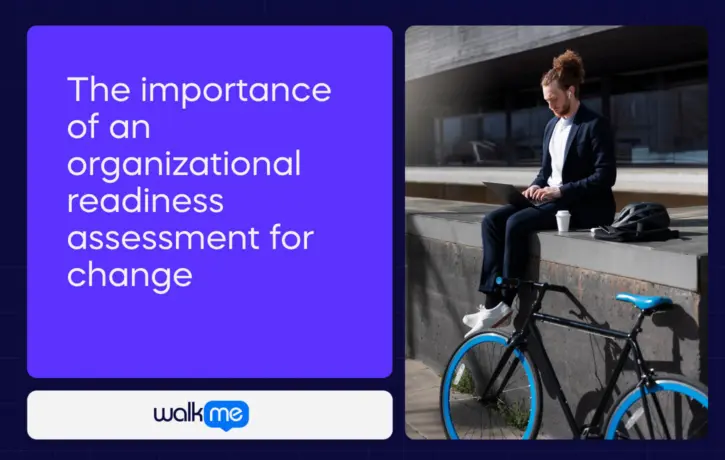Before executing an organizational change, assessing how your staff might receive the change and its potential success rate is beneficial.
Leaders frequently err by not evaluating their organization’s capacity for change, resulting in the initiation of transformations within an environment that is either unprepared or resistant. This neglect significantly underestimates the necessary time, resources, and efforts for successful change.
However, the key to a successful organizational change largely hinges on the leaders’ proactive role in aiding and readying their teams for the transition, necessitating a clear understanding of their present status and pinpointing areas needing enhancement.
Organizational readiness assessments are a strategic way to examine an organization’s preparedness for adopting a proposed change.
Undertaking a change readiness assessment allows you to identify and preemptively address possible challenges in implementing your change initiative.
By the end of this guide, you will understand:
- What an organizational readiness assessment is, and why it is beneficial for your business
- What this type of assessment should involve and examples of organizational readiness assessment tools
- The relevant steps to take to conduct an organizational readiness assessment
What is an organizational readiness assessment?
An organizational readiness assessment is a comprehensive evaluation determining an organization’s preparedness to implement a change. This assessment covers the organization’s capacity to initiate, sustain, and embed changes effectively over the long term.
To be truly effective, the assessment must examine the organization’s current structure and processes, staff, culture, leadership, and capacity to adopt change. Typically, professionals use the insights gained from a change readiness assessment to shape and inform a detailed change management project plan.
Why is an organizational readiness assessment beneficial for your business?

Organizational readiness assessments are vital in today’s fast-paced and constantly evolving business landscape. They play a vital part in helping organizations adapt and excel by pinpointing areas where they may not be fully prepared for upcoming changes. These assessments enable effective planning and preparation for future transitions. Here are some significant benefits of conducting organizational readiness assessments:
Allows you to visualize how changes sit with employees
These assessments are instrumental in understanding how changes will affect your employees. By putting your employees at the center of any new business change sooner, you can devise strategies to support them through the transition, ensuring their continued productivity and contribution to the organization’s success.
Proactive problem-solving
Organizational readiness assessments allow companies to identify potential issues or risks early on. Addressing these challenges before they escalate is crucial for saving time and resources and can even enhance the profitability of client-driven projects.
Makes successful change a likelihood
By clarifying the resources and capabilities needed to support a change, these assessments ensure you are well-equipped for successful business process transformation. For example, strategies to foster buy-in and demonstrate leadership support may be necessary if there’s a lack of commitment.
Similarly, if staff confidence or resource availability is low, additional support mechanisms might be required to engage them effectively in the change process or research activities.
Overall, organizational readiness assessments are a strategic tool for navigating change effectively, minimizing disruption, and maximizing the benefits of a digital transformation framework.
What should an organizational readiness assessment involve?

An organizational readiness assessment is a vital initial step in formulating a change management guide. These assessments serve as crucial elements in devising an effective change plan.
Key aspects to consider in your organization’s readiness assessment include:
Motivations for change
Unique priorities drive different parts of an organization. For example, the customer service team might focus on changes that enhance customer satisfaction and experience. In contrast, senior leadership might aim for new processes that boost ROI or align with strategic objectives.
Therefore, assessing organizational readiness for change requires understanding how changes affect employees’ daily tasks. Considerations include whether employees need additional employee training for new processes and whether this will encourage their commitment to the change.
It’s also crucial to evaluate if employees understand the necessity and rationale behind the change. Without this understanding, there’s a higher likelihood of resistance. This indicates a need for leaders to ensure that the change’s purpose, goals, and motivations are communicated and understood across the organization.
Capacity to handle change
In some cases, even if organizational change is desired, it might be hindered by staff workloads and limited resources. Key considerations include the office’s and physical space’s adequacy, which can impact staff’s ability to adopt new approaches. Insufficient space often reflects broader financial constraints.
Next, there needs to be adequate staff to implement the changes, which refers to the quantity and quality of staff. A business needs to assess whether employees can access the tools required for the change.
For example, legacy systems, which often suffer from IT issues, do not help implement change and would suggest that you transform your IT infrastructure in the first instance.
Tools also include appropriate training, and to assess this, your readiness assessment could involve asking a question like ‘There is a yearly budget for continuous learning and training, which every staff member is encouraged to use.’ You could then give employees the ability to choose an option on a sliding scale from ‘strongly disagree’ to ‘strongly agree.’
Staff readiness for change
Your organizational readiness assessment must also evaluate how well your staff can adapt to changes. For example, an assessment could ask a ‘strongly agree,’ ‘strongly disagree,’ ‘don’t know,’ ‘agree,’ or ‘disagree’ question like, ‘You are willing to trail new changes within your work day even if your colleagues are not supportive of it.’
If an employee chooses to disagree, you could also include a box for employees on the assessment to type in their reasons for their choice. You can also assess which staff members are more likely to be trusted by others.
For instance, one of your assessment questions could be, ‘Other staff often approach you for advice on processes and systems.’ The answer to this question can help an organization identify staff who could become change champions to influence others to accept change.
Next, you can also look at staff’s confidence in their current skill set. Lastly, incorporate a question that assesses which staff members value growth within their role.
For example, if an employee states that they agree with a statement like ‘You regularly read journals and articles every month to improve your knowledge,’ it shows they will be optimistic about change.
Organizational culture
For successful change implementation, an organization must cultivate a conducive culture. So, your readiness assessment needs to assess how a particular change’s goals and missions have been communicated to staff.
If staff indicate that they are not aware that their current work duties are related to the goals of the new change, then your change management strategy should involve more clarity about the new mission.
In addition, your assessment should also consider whether teamwork is the norm and whether management is receptive to feedback. A response to a question like ‘Managers favor open discussions about procedural issues regularly’ could indicate whether there is an openness of communication.
Next, you can also look at whether employees think that leadership values their professional judgment, which could indicate that staff have autonomy when carrying out their work.
Following this, getting answers to questions like ‘there is too much pressure to carry out your role effectively’ could suggest that the company’s culture needs to be improved as there is too much stress on employees. Finally, it is vital to assess openness to change to see whether change is accepted readily.
Organizational readiness assessment tool examples
While you can use the above factors to build your organizational readiness assessment tools, it is helpful to look at other tools to ensure that your assessment is thorough.
Here are some examples of organizational readiness assessment tools:
- Organizational Readiness For Implementing Change (ORIC) based on B.J. Weiner’s theory of organizational readiness for change
- Organizational Readiness To Change Assessment (ORCA) based on the framework for ‘Promoting Action On Research In Health Services’
- Organizational Capacity Assessment (OCA) by PACT
- Capacity Assessment Framework from the United Nations Development Programme
A step-by-step guide to conducting an organizational readiness assessment

Determining if your organization is ready and capable of change involves thoroughly examining your team members’ attitudes, behaviors, and everyday experiences. Regardless of the technical nature of the change program, its success hinges on the acceptance and adoption by people.
Below is a systematic approach for effectively conducting an organizational readiness assessment in your business:
1. Understand the goals and mission of your change
Begin by comprehending the project’s objectives and identifying which groups will be impacted by the change. Clarify what ‘readiness’ entails for this project, pinpointing the groups primed for the upcoming changes.
This involves assessing how the change will influence various teams’ roles, responsibilities, and procedures. Once you grasp the project’s goals and the affected parties, you can precisely outline all aspects of the change and engage relevant stakeholders from the outset.
It’s also crucial to consider the scope and timeframe of the change. Being detailed in these areas allows a more accurate evaluation of your organization’s capacity to embrace the change. By doing so, you can articulate a clear and persuasive vision of the change, ensuring that your team is aligned with the organization’s strategic objectives.
2. Measure the readiness of your organization
This subsequent phase involves evaluating your team’s preparedness to embrace the change. You can employ various methodologies for data collection, including surveys and direct observations.
It’s essential to pose open-ended yet precise questions to uncover your team’s awareness, understanding, commitment, and confidence concerning the change.
You can select from various organizational readiness assessment tools, customizing them to fit your specific context. Consider tailoring these tools to align closely with your organization’s unique requirements.
On the other hand, you can use these pre-existing tools as a foundation and develop your customized assessment. The chosen tools should effectively evaluate the organization’s overall capacity for change, the existing workplace culture, the staff’s readiness, and their motivations for the impending change.
3. Analyze the initial results
In the third step, scrutinize the data gathered to pinpoint the gaps, strengths, and weaknesses in your team’s readiness for change. Evaluate if there’s a need for more detailed one-on-one interviews with team leaders or focus group discussions to delve deeper into specific responses.
This in-depth exploration aids in forming a well-rounded view of the employee experience, which is essential for implementing effective change. The initial findings also provide insights into the resources, skills, actions, and responsibilities required to ensure the change initiative’s success.
4. Create an implementation strategy based on your assessment responses
It’s essential to recognize that your organizational readiness assessment is distinct from your project plan. Use the assessment to evaluate the likelihood of successful implementation and identify potential obstacles.
With this information at hand, integrate it into your formal project planning. Start by creating a change management project plan that outlines the steps necessary to address any readiness challenges identified.
Then, assemble a change management team. This type of team will play a crucial role in implementing changes, collecting feedback, and modifying plans as necessary. They are also instrumental in monitoring and tracking the progress of the change.
Consider the timeline for enacting these changes. Remember, change is often most effective in gradual, manageable stages.
5. Track the progress of the change in practice
During the implementation of changes, it’s crucial to monitor progress and remain vigilant for any resistance signs. Utilizing digital adoption software can be beneficial in tracking potential issues and offering the necessary support to employees as they integrate changes into their workflows.
If you encounter negative performance or feedback, this can inform and potentially adjust your change management plan, indicating the need for another organizational readiness assessment.
Regular input from your change management team and other stakeholders is also vital. This feedback should acknowledge successes, pinpoint lessons learned, and formulate best practices. Such insights are invaluable as they can inform and improve strategies for a future business transformation.
Final thoughts on the role of an organizational readiness assessment for change management
Using organizational readiness assessments within a suitable change management framework is beneficial for shaping your change management strategy and guiding the project team in making well-informed decisions regarding their approach to change management.
It’s crucial to recognize that these assessments serve as a tool for planning and are not the primary component of the change management process. To facilitate planning for change, these assessments should be time-efficient, requiring only enough duration to provide insights for sound planning decisions.
Finally, it’s essential to understand that organizational readiness assessments are not a one-time activity. The initial assessment should lay the groundwork for your overall change strategy.
You can conduct subsequent assessments to gauge progress, see how circumstances or attitudes have shifted, and identify any adjustments needed in your change strategy. These iterative evaluations are crucial for adapting and refining your approach as your organization develops through the change process.


